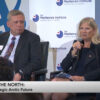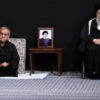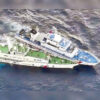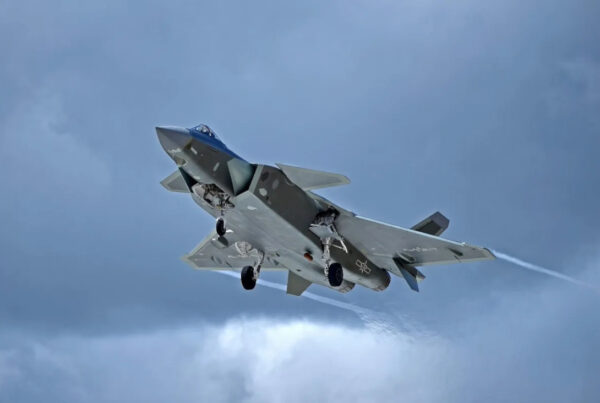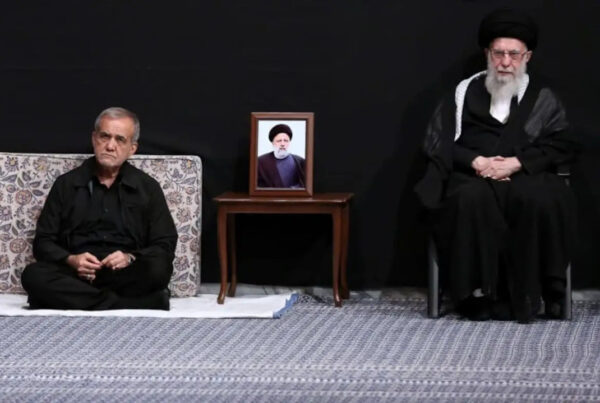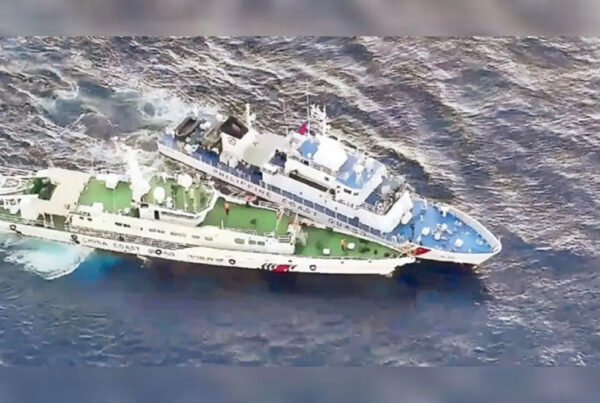In 2006, the Canadian Security Intelligence Service (CSIS) reported that extremist groups operating in Canada were routinely fundraising, procuring materials, spreading propaganda and recruiting in efforts to support terrorist activities internationally. In fact, by 1998, every major terrorist group in the world was operating in Canada. Former CSIS director, Ward Elcock, said that, “with perhaps the singular exception of the United States, there are more international terrorist groups active here than any other country in the world.” [1]
The 2006 arrests of 18 Muslim Canadian men charged with plotting terrorist attacks on Canadian targets highlighted the new reality that the threat of terror groups was also becoming a “homegrown” domestic reality. In the wake of this most inconvenient truth, Environics Research Group conducted a survey of Canadian Muslims’ life satisfaction. While 80% felt satisfied with their lives here, and 73% felt the ‘Toronto 18’ terror plot was abhorrent, 12% believed it to be at least somewhat justified. The population sample–representative of 84,000 Muslim Canadians—considered the planned bombings of Toronto’s financial institutions and the Prime Minister’s beheading to be justifiable. [2]
Canada has inadvertently provided fertile ground for incubating terrorists and exporting them around the world by overtly failing to respond to the groups living and operating within the country. [3] As far back as 1998, CSIS director Elcock testified that Canada was developing the reputation of being a terrorist haven. “We cannot become,” he asserted, “through inaction or otherwise, what might be called an unofficial state sponsor of terrorism.”[4]
Canada as a Base of Operations
The U.S. Special Senate Committee on Security and Intelligence, as far back as 1999, described Canada as a venue of opportunity to support, plan, or mount attacks elsewhere and provide a convenient point of entry to the United States. In a CSIS report of that same year, titled The Exploitation of Canada’s Immigration System: An Overview of Security and Intelligence Concerns, numerous activities that directly support terrorism were identified: 1) document fraud for planning and logistical support of terrorist operations; 2) procuring weapons and materials; 3) recruitment; 4) manipulation of diaspora community members; and 5) providing a safe haven for terrorists. [5]
Terrorist Financing
In 2006, the RCMP expressed concerns over the potential failure to appropriately deal with terrorist financing:
“If the RCMP is unable to address terrorist financing issues in an appropriate manner, Canadians and our allies would be in an environment of elevated risk. Terrorist financiers could focus on Canada as an operating base, which could undermine the integrity of Canada’s financial system and its reputation.” [6]
Money Laundering from terrorist activities was addressed under pre-existing Canadian criminal law prior to 2001. Specific terrorist financing legislation had been drafted but wasn’t tabled until after 9/11. In passing the new legislation the federal government’s intention was, “to create a hostile environment” [7] towards terrorist financing. Post-9/11, the Proceeds of Crime (money laundering) Act was amended and replaced by the Proceeds of Crime (money laundering) and Terrorist Financing Act (PCMLTFA), which, along with the Criminal Code, is the main legislative tool used today to combat terrorist financing in Canada. [8]
Canada’s Financial Transactions and Reports Analysis Centre (FINTRAC) ensures compliance with the PCMLTFA by operating at arm’s length from law enforcement and intelligence agencies. FINTRAC’s mandate is to facilitate the detection, prevention, and deterrence of money laundering, terrorist financing activities, and related threats to Canada’s financial security by monitoring suspicious banking activities. Unfortunately, the agency has been criticized for being less than effective in carrying out its mandate; insufficient access to intelligence information from CSIS, CRA, and Customs has impacted its functionality. [9]
Fundraising for terrorist groups was legal in Canada prior to 2001. Prior to 2006, before they were listed as a terrorist entity in Canada, [10] Tamil Tigers–or Liberation Tigers of Tamil Eelam (LTTE)–were able to raise money from Canadians to fund the most successful suicide bombing operation on the planet. [11] Stewart Bell, in Cold Terror, explains, “it is easy enough to set up a charity dedicated to a worthy humanitarian cause and launder the money instead to terrorist causes.” [12] FINTRAC reported that from 2004-2005 $180-million CAD had been channeled to terrorist groups. [13]
According to a Canada Revenue Agency (CRA) audit obtained by the Toronto Star nearly $15 million of Canadian charitable donations between 2005-2009 were sent overseas to 15 groups identified as labeled terrorist organizations. Of note are numerous Hamas controlled organizations, including over $9 million to the Zakat Fund in Lebanon, a group with membership in the Union of Good, a direct Hamas supporter, and $3.5 million to the Islamic Medical Association in Lebanon, which maintains close ties with Jamma Islamiya (Muslim Brotherhood) in that country. [14]
The audit states that International Relief Fund for the Afflicted and Needy (IRFAN-Canada), a Mississauga-based charity, used “deceptive fundraising” [15] to support Hamas. Amongst a number of findings, the CRA claims the charity redistributed more than $580,000 raised for disaster relief projects to sponsor programs in Gaza and the West Bank. [16] The audit further noted that records were often an “after-the-fact paper exercise” documenting $17 million in “gifts-in-kind” for projects outside Canada during that period. [17] These gifts were apparently transferred to organizations with ties to Hamas. The CRA said IRFAN-Canada has damaged the integrity of the Canadian charity system.
While the organization has subsequently been stripped of its charity status–and can no longer issue tax receipts to donors–it is still permitted to function in a not-for-profit capacity. The charity was listed as a terrorist entity pursuant to the Criminal Code of Canada on April 24, 2014. [18]
The Jerusalem Fund for Human Services (consolidated with IRFAN-Canada in 2001), World Tamil Movement, Kurdish Information Network, and Babbar Khalsa are just a few of the terrorist organization front groups in Canada known to invite politicians to fundraising functions. [19] Politicking for the ethnic vote has been common practice in Canada. Paul Martin, for example, when criticized for attending a dinner sponsored by a group associated with the Tamil Tigers, unapologetically stated that such criticism was “un-Canadian.” [20] However, governments have traditionally been reluctant to oppose potential voter blocks because the ethnic vote in Canada holds such tremendous weight. Taking a stand against domestic terrorism by refusing to pander to front groups, risks losing the ethnic vote, and consequent political suicide. The strategy, instead, has been to deny the problem exists. [21]
“Criminal Extremism” describes the nexus between terrorist groups and organized crime. Historically, ideological differences separated the two but money has become the common denominator; it is the goal of criminals and the enabler of terrorists. Crime serves to finance terrorism in Canada. [22] While some terrorist groups have embraced criminal activities in order to finance their operations, in the case of the Tamil Tigers, criminals formed terrorist groups. According to the Toronto police Tamil task force, there were as many as 8,000 members of, “Tamil terrorist factions” in Toronto in 2000. [23] Activities most commonly involve bank fraud, migrant smuggling, credit and debit card fraud, mortgage fraud, theft, extortion, and money laundering.
In 2012 John Thompson suggested that the LTTE created a Sri Lankan diaspora as a mechanism to maintain an international support structure. [24] Canada’s immigration policies opened the door to a massive influx of Tamils. “In 2003 Canada gave refugee status to 1,749 Sri Lankan asylum seekers–more than the total accepted by the rest of the world combined.” [25]
The 1983 riots in Sri Lanka led to the internal displacement of hundreds of thousands of Tamils; supporting these refugees drained LTTE resources. The solution was to expatriate them and allow them to settle and integrate into host countries, at which time they could be “taxed” for the war effort back home. The World Tamil Movement became the front organization for the Tigers worldwide. The taxation system instituted in Sri Lanka was eventually extended throughout the Tamil diaspora. [26] Ex-guerrillas living among them would extort money from those with family still living in Sri Lanka by threatening the safety of their relatives if money was not paid. [27] LTTE fundraisers compiled lists of profitable Tamil businesses and owners were demanded to pay out 20% of their profits. New families on welfare were also expected to pay up. Human Rights Watch concluded that in 2006 the average Tamil family in Toronto paid $200-$400 per month and some businesses in excess of $8000 per month. [28] Despite the 2009 military defeat of the Tigers by the Sri Lankan government, it is believed that LTTE criminal activities continue to operate among the Tamil diaspora. Reportedly, close to 60 LTTE successor groups exist in the West. [29]
Human Smuggling and Document Forgery are other common forms of terrorist fundraising. Human smuggling typically involves forged refugee documents; the smugglers purchase passports from diaspora community members and modify them with new photos and personal information. The forged documents are then smuggled out of Canada so they can be used upon entry, and then returned to the smugglers to be reused. Canadian Tamils operated at least fifteen forgery shops in southern Ontario. [30]
According to James Bissett Canada is the country of choice for human smuggling. [31] Thanks to what he describes as Canada’s failing immigration system, smugglers can all but guarantee their clients will not be removed from the country. [32] Even if asylum seekers are denied refugee status, they are unlikely to be deported because of the length of time spent in the country awaiting judicial hearings. [33]
While the LTTE made a profession out of document forgery, it is not the only terrorist/criminal organization to have done so. Between 1998 and 2000, Canadian immigration officials reported 2200 misuses of passports, which included fraudulent alterations, use of stolen passports, borrowing passports, and illegally obtaining legitimate passports. [34]
Finally, in 2006, the newly elected federal Conservative government added the LTTE and the World Tamil Movement to its list of illegal terrorist entities. Tamil Tiger fundraising, in all its various forms, became illegal in Canada. [35]
Procurement
Lebanon’s Hizballah has maintained a procurement network in Canada since the 1980’s. The terrorist organization depends on financial support from the Shi’a Islamic diaspora around the world. According to a report by the U.S. Special Operations Command, “North America has long served as base for a wide variety of Hizballah criminal enterprises, ranging from fundraising to recruiting to forging travel documents to procuring dual-use items for the group.” [36] In terms of procurement, specifically, Canadian Hizballah agents purchase technological items easily obtainable in the open market and ship them overseas where these items are used in the manufacturing of weapons and equipment. [37]
Mohammad Hussein al Husseini, deported from Canada in 1994, said that Hizballah had members living throughout the country. [38] Mohammed Dbouk was an Iranian-trained Hizballah operative dispatched to Canada for the purpose of procuring military and surveillance equipment. Under his direction, the Hizballah procurement network in Canada engaged in many criminal activities including passport fraud, credit card fraud, immigration fraud, and the use of counterfeit money. Dbouk, in fact, was rejected for suicide missions five times because he was considered too valuable to the procurement network to be killed. [39] In support of the effort, the Canadian network considered supplementing its income through the import of counterfeit Canadian $100 bills printed in Lebanon but it already had more than enough money through its basic credit card fraud schemes. [40]
The Domestic Threat
Documents recovered from two Al-Qaeda operatives in Afghanistan in 2003 contained a list of Toronto landmarks including Union Station and the Eaton Centre. According to a classified CSIS report, “Canada is no longer regarded as simply a safe haven for criminal and logistical support activities. Canada is a viable terrorist target.” [41]
Project OSAGE was a 2005 criminal investigation—under the Anti-terrorism Act—conducted by a Canadian inter-agency task force, the O Division Integrated National Security Enforcement Team (INSET), which coordinated the activities of the RCMP, CSIS, CBSA, the Ontario Provincial Police, Toronto Police Services, and other regional police forces. CSIS had been watching the online activities of a group of Toronto youth since 2004, whose “terminology and use of words stood out.” [42] A mid-winter weapons training camp near Orillia, ON was monitored by 200 police officers. [43] A second training weekend in May 2006 at the Rockwood Conservation Area indicated that the group had actualized its intent and capability. [44] Although the cell members knew police were watching them, they continued to plan. Once their intent was deemed a public safety threat the police moved in. Seventeen people were initially arrested, with the eighteenth following a short time later. [45]
Not only can it happen here, it is happening here. The arrests of the ‘Toronto 18’ in 2006 should have been a wake-up call to Canadians that terrorism in Canada has evolved from an operational planning base for international conflicts, to homegrown terrorists with Canadian-born grievances. We are dealing with youth who were either born in Canada or immigrated here at a young age. They are not infiltrating the country; they were raised here and radicalized here. [46]
To some extent Canada is prone to terrorist infiltration; geographically the country has vast unprotected coastlines and a sparse population in relation to its landmass. Canada has large ethnic communities that provide a haven for those looking to hide, as well as raise money, and recruit. [47] Canada is also a modern and wealthy country providing a source of easily obtainable technology, equipment, and funds. Stewart Bell writes in Cold Terror, “terrorists can now recruit, train and conspire within the comfort of the West…by exploiting the liberal democracies of the world.” [48]
In some cases, ethnic or religious grievances are displaced. For example, in the foiled 2013 VIA Rail terror plot, Raed Jaser planned to act upon past grievances he experienced as a teenager living with his family in Germany. [49] Twenty years after fleeing to Canada from Germany where his family had reportedly been “terrorized” by anti-immigrant groups, the eldest Jaser son was arrested on terrorist charges along with co-conspirator, Chiheb Esseghaier, for plotting to derail a passenger train near Toronto. [50] Esseghaier was a PhD student in biotechnology at Sherbrooke University near Montreal. Colleagues reported that he had very strict religious views, citing his frequent complaints that the university would not provide a prayer room and move to tear down school posters presenting images of women. [51] The expression of such grievances appears to be personally motivated; some radicalized individuals seek to act out at home while others seek an international outlet.
Radical Tourism
We are witnessing a new trend in how Canada provides a base for the incubation and exportation of terrorism. Akin to medical tourism, young Muslims are travelling abroad to join the jihad and then returning home. In one case, Ahmed Khadr returned to Canada for medical treatment after stepping on a landmine. After becoming disillusioned with Western cultural values, he returned to Pakistan where he became al Qaeda’s commander in Logar Province. [52] While it is difficult to know just how many Canadians are fighting overseas, the current estimate is anywhere from 9 to 100. [53] Canadians have been implicated in attacks in Algeria, Bulgaria, and Somalia in the past year, but “…the Syrian conflict has become the top attraction for radicalized youths.” [54]
Among the newsworthy Canadians fighting the jihad were two high-school friends from London, Ontario, killed last year during a four-day siege of an Algerian gas plant. As well, the Canadians killed recently in Syria; 22 year-old Muslim Convert Damian Clairmont (aka, Mustafa al-Gharib) Ali Mohamed Dirie, who left Canada on a fake passport in 2012 after serving jail time for his role in the ‘Toronto 18’ plot, and Andre Poulin (aka Abu Muslim) from Timmins. [55]
What motivates Canadians to travel abroad to fight jihad? While some have been inspired to fight the Assad regime after viewing images of mass slaughter, others have been radicalized by al Qaeda’s Salafist ideology. [56] The latter may involve hijrah, a historical reference to the escape of the Prophet Muhammad from an assassination plot. Hijrah is cited as a precursor to carrying out jihad or terrorism, and encompasses the desire to “flee from sin”. Bin Laden noted that hijrah was obligatory for Muslims living in non-Muslim lands to prevent corruption by their stay among the unbelievers. [57] Other extremists have encouraged Muslims to travel overseas to defend Islam from its enemies. [58]
Confronting the Domestic Risk
Taking seriously the potential threat of Canadians returning home with paramilitary training, combat experience, extremist ideological beliefs, and international contacts, Ottawa recently passed Bill S-7 to amend the Combating Terrorism Act. One of the principal tenets of the bill makes it a crime to leave or attempt to leave Canada to participate in terrorist activities. [59] Final readings of the bill were fast-tracked following last year’s Boston Marathon bombings and the arrests of the two Canadians connected with the VIA Rail plot. Yet NDP public safety critic Randall Garrison criticized the bill, saying it added few tools to law enforcement since it was already illegal to leave Canada for the purpose of terrorism. [60] And furthermore, such clauses are overshadowed by cut backs in other critical areas of public safety such as 100 intelligence officers at the border services, “so if we’re really going to attack terrorism,” argues Garrison, “let’s have that proper balance between the resources we need and the existing laws.” [61]
It has been alluded to by one undisclosed source that it was U.S. intelligence agencies, in fact, that alerted Canadians of the train attack plot; that Canadian intelligence services simply do not have the necessary resources or infrastructure to gather that kind of intelligence. According to evidence provided before the Standing Committee on Citizenship and Immigration during the 41st Parliament in 2012, LCol Walter J. Perchal argued that sound decision-making within the government on matters of security and safety for Canadians requires the need of a more, “elegant intelligence interface” for sophisticated information sharing between silos. [62] He noted an inability to leverage intelligence assets to further our collective national interests, preventing effective policy and initiative development and implementation. As such, “current policy is reactive rather than proactive.” [63]
In the same Parliamentary session, U.S. Admiral Donald Loren called for a greater partnership between our two countries to address shared concerns of immigration and border security where policies and programs must be in alignment. This involves sound intelligence gathering and law enforcement partly through international partnerships for sharing signal and electronic intelligence vital to the efforts of CSIS to carry out its mandate. Such partnerships provide access to information that CSIS cannot obtain on its own (it is illegal to spy on one’s own country) for the purposes of assessing domestic threats and the potential risks posed by individuals attempting to enter the country. [64]
What the Canadian public, by and large, has failed to comprehend is that the security risk is not a uniquely American problem. Human rights and personal freedoms we share with our ally make Canada a viable target to those looking to disrupt a free and open society. In an unclassified document released by the Integrated Threat Assessment Centre (ITAC) in 2012, Canada was confirmed as a key target of Islamist terrorism. Reasons cited include participation in Western military and political alliances, involvement in Coalition forces in Afghanistan, its support of Israel and the United States, and its geographic proximity to the United States. [65] Canada was ranked fifth out of seven Western countries bin Laden identified as targets. Every other country on that list has been attacked. [66]
If or when a significant attack does occur on Canadian soil, we can be sure the sitting government will make any and all legislative changes deemed necessary to ensure such an event does not happen again, as the Americans did with the immediate passing of the U.S.A. Patriot Act. We have worried that counterterror measures might infringe too heavily on our rights and freedoms. However, in the effort to strike a balance between security and freedom we may have left ourselves vulnerable. In the concluding remarks of Cold Terror, Stewart Bell poignantly asserts that in a country with such a high percentage of foreign-born citizens and a global appeal for immigrants, Canada “…should logically have the toughest antiterrorism policies and the lowest tolerance for terrorists, because in such a society the potential for exploitation by terrorists is so great.” [67]


